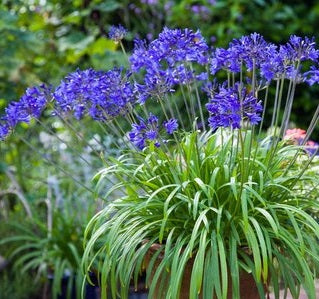Stunning Agapanthus: Enhancing Your Garden's Beauty
Stunning Agapanthus: Enhancing Your Garden's Beauty
Blog Article
Understanding the Art of Agapanthus Care: Necessary Steps for Healthy Growth and Vivid Blooms
In the world of gardening, the cultivation of agapanthus stands as a rewarding undertaking for those that seek to nurture these elegant blooming plants. From choosing the best variety to understanding trimming techniques, the trip in the direction of cultivating thriving agapanthus plants is complex and holds the crucial to unlocking the complete capacity of these botanical treasures.
:max_bytes(150000):strip_icc()/agapanthus-growing-guide-7368912_04-66a3f4cf245b4332b28954dd37c784f5.jpg)
Choosing the Right Agapanthus Selection

When choosing the best Agapanthus range for your yard, think about aspects such as environment viability, blossom shade, and development behavior. Agapanthus, commonly called Lily of the Nile or African lily, comes in a variety of colors varying from tones of purple and blue to white. Pick a blossom shade that enhances your existing yard combination to produce an unified landscape. Additionally, think about the environment in your area to make certain the Agapanthus variety you select can thrive in your details conditions. Some selections are much more tolerant of cold temperature levels, while others prefer warmer climates. Understanding the growth behavior of various Agapanthus ranges is vital for appropriate placement within your yard. Some ranges have a clumping growth habit, suitable for borders or containers, while others have an even more spreading nature, ideal for ground cover or mass growings. By thoroughly assessing these factors, you can pick the ideal Agapanthus variety to boost the charm of your garden.
Ideal Growing Problems
Taking into consideration the optimum ecological needs is crucial for successful Agapanthus farming. Agapanthus thrives in well-draining dirt with a somewhat acidic to neutral pH level. When planting, pick a location that gets complete sunshine to partial shade. In hotter climates, supplying some mid-day shade can stop scorching of the fallen leaves. Agapanthus plants are sensitive to chilly temperature levels and need to be safeguarded from frost during cold weather.
To ensure healthy and balanced development and vivid blossoms, plant Agapanthus bulbs at a deepness of regarding 2-4 inches and room them 8-12 inches apart. Mulching around the base of the plants aids maintain wetness and suppresses weed development.
Watering and Feeding Tips
Preserving correct moisture degrees and giving vital nutrients are vital elements in the care routine for Agapanthus plants. When it comes to sprinkling Agapanthus, it is vital to strike a balance. These plants favor continually wet dirt however are at risk to root rot if overwatered.
Feeding Agapanthus is crucial for promoting healthy development and respected blossoms. Apply a well balanced fertilizer, such as a 10-10-10 formula, in the very early spring as new growth arises. Repeat this application every 6-8 weeks throughout the growing season. Avoid excessive fertilization, as it can cause rich foliage at the cost of blossoms. Constantly follow the producer's directions for appropriate dilution and application techniques. By complying with these watering and feeding tips, you can guarantee your Agapanthus plants prosper and generate vivid, long-lasting blooms.
Pruning Techniques for Agapanthus
Pruning Agapanthus plants at the appropriate times and with correct strategies is critical for keeping their health and wellness and promoting optimal development and flowering. The ideal time to trim Agapanthus is in late wintertime or early spring prior to new development emerges.
Deadheading spent flowers can additionally redirect the plant's power into generating more flowers rather than establishing seeds. If you desire to gather seeds for breeding, leave some blossoms to completely dry and mature on the plant.
Keep in mind to this page use tidy, sharp devices to make accurate cuts and lower the threat of presenting illness. Agapanthus. Normal Web Site pruning will aid maintain your Agapanthus looking neat and healthy while making sure a plentiful display of attractive blooms
Taking Care Of Usual Pests and Illness
After guaranteeing proper pruning strategies for Agapanthus, it is essential to address usual parasites and conditions that can influence the health and wellness and vitality of these plants. One common pest that affects Agapanthus is the Agapanthus gall midget.
Furthermore, Agapanthus plants can endure from origin rot if they are planted in inadequately draining dirt. By being alert and taking prompt activity against diseases and bugs, you can help your Agapanthus plants prosper and produce vivid flowers. Agapanthus.

Final Thought
In final thought, understanding the art of agapanthus treatment entails choosing the ideal selection, giving ideal planting conditions, proper watering and feeding, ideal trimming strategies, and resolving usual parasites and illness. By complying with these necessary actions, you can make sure healthy growth and vibrant blossoms for your agapanthus plants. Bear in mind to consistently check and keep your plants to promote their overall well-being and long life.
To make sure healthy development and lively blooms, plant Agapanthus bulbs at a depth of about 2-4 inches and room Discover More Here them 8-12 inches apart. By adhering to these watering and fertilizing ideas, you can ensure your Agapanthus plants flourish and generate lively, lasting blooms.
One usual insect that affects Agapanthus is the Agapanthus gall midget. Furthermore, Agapanthus plants can suffer from origin rot if they are planted in inadequately draining dirt. By complying with these vital steps, you can make sure healthy development and dynamic blossoms for your agapanthus plants.
Report this page